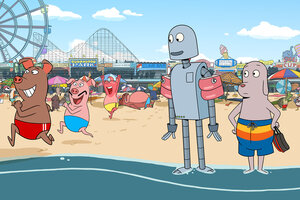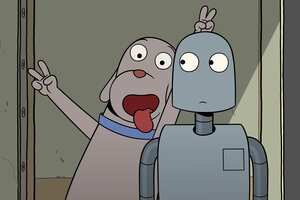‘Robot Dreams’ review: This animated delight explores friendship and loss

“Robot Dreams,” which features fast friends Robot and Dog, was a 2024 Oscar nominee for best animated feature.
NEON
Animated movies are the ultimate conjuring act. We are drawn into a world of graphic stylization that, at its best, carries the same emotional impact and allurement as any nonanimated drama.
Pablo Berger’s whimsical “Robot Dreams,” a tribute to the beauty and frailty of friendship, certainly fits this description. Set in a 1980s New York City almost entirely populated by animals, and with virtually no spoken dialogue, the film affected me in much the same way as last year’s “Past Lives,” which was also about the fragility of the ties that bind.
Of course, “Robot Dreams,” a fantasia about a dog and a robot, is a very different sort of film. But it earns its tears just as honestly. Why should this be a surprise? If we can be transported by the power of a great painting, why should a great animated movie afford us any less of an experience?
Why We Wrote This
When an animated film is invested with the full range of feeling, the result is “Robot Dreams.” The movie is a tribute to the beauty and frailty of friendship, our critic writes.
We first encounter Dog in his depressingly sparse third-story apartment on the Lower East Side. Watching TV while downing his microwaved TV dinner, he takes note of a commercial for a do-it-yourself robot kit that asks, “Are You Alone?” Dog may be a loner, but he’s industrious. Soon he and Robot, his mail-order buddy, are inseparable.
The scenes of them jaunting around their neighborhood are elating. The blocks are teeming with rhinos, giraffes, ostriches, pigs, ponies, raccoons, and sundry other critters. The Spanish-born Berger lived in New York for 10 years and has said in interviews that “Robot Dreams” is his “love letter” to the city. It shows. His cityscapes are a multiethnic menagerie spilling over with the rough bustle of street life. The anthropomorphism on display is anything but cutesy.
Waiting for the First Avenue subway, Dog and Robot are loudly serenaded by an octopus knocking out a drum solo, sticks flying high in the air. The pair skate through Central Park, boogying to the beat of their favorite song, Earth, Wind & Fire’s “September.” A day at Coney Island is bliss until it becomes clear that the seawater has rusted Robot’s joints. Immobile, lying face up on the sand, he awaits Dog’s rescue mission. But unbeknownst to them both, the beach season has just ended. Dog’s frantic nighttime attempts to break through the fencing and save Robot leads to his arrest. A snowy winter awaits.
The source material for “Robot Dreams” is the eponymous 2007 graphic novel by the esteemed Sara Varon, whose books also include “Bake Sale,” about the friendship between a cupcake and an eggplant. Along with his art director José Luis Ágreda and animation director Benoît Féroumont, Berger has not so much reimagined as intensified Varon’s storybook vision. His dramatized dream sequences for both Dog and Robot, as they imagine their reunion, have the effect of heartbreaking wish-fulfillment fantasies. The byways of hope all lead to rude awakenings.
Besides Varon, Berger was clearly inspired by “The Wizard of Oz” and such popular artists as Buster Keaton, Charlie Chaplin, Busby Berkeley, and Jacques Tati. Above all, the look and feel of the film is a nod to the graphics of Hergé’s “Tintin” books, which Berger has described as a “visual punch” – clear lines, limited shadows, flat colors. The unfussy design of “Robot Dreams” should not be mistaken for a lack of complexity. On the contrary, the clean graphics summon us straight into the story’s emotional heart.
I greatly admire the voluptuous, free-form lyricism of animators like Hayao Miyazaki, but what Berger does here, in its own scaled-down way, is just about as robust. He’s a voluptuary of the everyday. This is his first animated movie, having directed three previous live-action features. He honors the animation medium by investing it with a full range of feeling – just as if he were making a movie with real people.
This is another way of saying that “Robot Dreams” is a film for adults perhaps even more than for children. It’s a movie about overcoming loss, and that is an emotion that can certainly resonate across generations.
Peter Rainer is the Monitor’s film critic. “Robot Dreams” is unrated.


